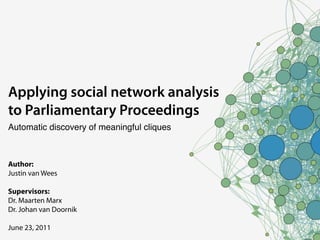Applying social network analysis to Parliamentary Proceedings
- 1. Applying social network analysis to Parliamentary Proceedings Automatic discovery of meaningful cliques Author: Justin van Wees Supervisors: Dr. Maarten Marx Dr. Johan van Doornik June 23, 2011
- 2. Why? Motivation and research question
- 3. Research question Can we discover communities of politicians that debate on a speci c policy area? Motivation ? ItˇŻs unknown which member is responsible for a certain policy area ? Discover what issues are discussed within a policy area ? Serve as example application of social network analysis techniques
- 7. <root> <docinfo>...</docinfo> <meta>...</meta> <proceedings> <topic> <scene type="speaker" speaker="Hamer" party="PvdA" function="Mevrouw" role="mp" title="Mevrouw Hamer (PvdA)" MPid="02221"> <speech party="PvdA" speaker="Hamer" function="Mevrouw" role="mp" MPid="02221"> <p>Dat is helemaal niet waar. U bewijst nu voor de derde keer dat u niet ...</p> </speech> <speech type="interruption" party="Verdonk" speaker="Verdonk" function="Mevrouw" role="mp" MPid="02995"> <p>Mag ik even uitpraten? Dank u. Zo werkt dat, gewoon fatsoen. Dank u wel. [...]</p> </speech> </scence> </topic> </proceedings> </root>
- 10. 42 32 21 12 84 100 10 8 15 A weighted directed graph
- 11. .8&&%9":3()(;&/%3<"3='()(,- 8 456",,%#()(+77()(,- 8 2 4 !"#$%&'()(**+()(,- 2 4,"2'()(B1$A()(,- >":#%1%#$)456/?2%3()(@+A()(,- .//0%&1/&'2()(0/1%&3,%32 A single debate represented in a graph
- 12. Debates during Cabinet Kok II
- 13. A community A group of nodes that are relatively densely connected to each other but sparsely connected to other dense groups in the network
- 14. A k-clique (k = 4) K-clique communities (k = 4)
- 15. Finding issues that a community is discussing ? Retrieve all ˇ®community textˇŻ ? Tokenized at word level ? Lemmatize ? Use parsimonious language models to nd most ˇ®descriptiveˇŻ terms
- 17. General network statistics of Kok II No distinction With distinction between MP/MG between MP/MG roles roles Nodes 211 218 Edges 3594 3615 Density 0,081 0,076
- 18. Finding k-clique communties ? By default, found groups are note ˇ®cohesiveˇŻ ? Filter out ˇ®noiseˇŻ by setting a threshold on edge weights ? At 15 interruptions: 197 nodes, 741 edges, 31 k-clique communities
- 21. Finding k-clique communties ? All k-clique communities could be traced back to a single policy area ? Except for more ˇ®generalˇŻ policy areas ? 92% of the community members directly related to the policy area covered by the community ? 85% of top 20 ˇ®issue termsˇŻ relevant to policy area ? K-clique community detection and parsimonious language models are successful methods for automatic discovery of communities within debate networks
- 22. Discussion ... and future research
- 23. ? Method for setting edge weight threshold ? Reviewing of k-cliques done by single person ? Used four years of data, shorter time-window possible? ? Focused on Cabinet Kok II, what about other (earlier) cabinets? ? Completely di?erent data?
- 24. Questions? For detailed results, datasets and programs see: http://justinvanwees.nl/goto/bachelorscriptie






![<root>
<docinfo>...</docinfo>
<meta>...</meta>
<proceedings>
<topic>
<scene type="speaker" speaker="Hamer" party="PvdA" function="Mevrouw"
role="mp" title="Mevrouw Hamer (PvdA)" MPid="02221">
<speech party="PvdA" speaker="Hamer" function="Mevrouw"
role="mp" MPid="02221">
<p>Dat is helemaal niet waar. U bewijst nu voor de derde keer
dat u niet ...</p>
</speech>
<speech type="interruption" party="Verdonk" speaker="Verdonk"
function="Mevrouw" role="mp" MPid="02995">
<p>Mag ik even uitpraten? Dank u. Zo werkt dat, gewoon fatsoen.
Dank u wel. [...]</p>
</speech>
</scence>
</topic>
</proceedings>
</root>](https://image.slidesharecdn.com/bachelorscriptie-eindpresentatie-110701035134-phpapp01/85/Applying-social-network-analysis-to-Parliamentary-Proceedings-7-320.jpg)
















